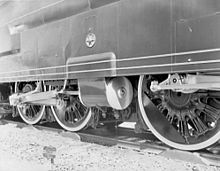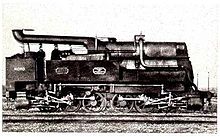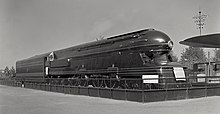Duplex locomotive

A duplex locomotive is a type of steam locomotive in which two groups of coupling axles are rigidly mounted in a common frame . The name "Duplex" did not come about until the 1930s in the USA ; The first locomotives of this type were designed in the 19th century, but otherwise had little in common with their modern successors.
Overall, this type of construction was very rare; there have been only a little over a hundred duplex locomotives worldwide. However, the most powerful steam locomotive ever was such a locomotive. Even if there were no official record runs, one can assume that duplex locomotives were also the fastest steam locomotives.
Advantages and disadvantages
The advantage of the duplex construction was that the individual engines had to withstand lower piston forces, so the pistons and rods could be built lighter and therefore ran more smoothly at higher speeds. The design was therefore particularly suitable for fast locomotives; However, there were also duplex locomotives in which one wanted to drive as many axles of the vehicle as possible in order to achieve high tractive forces , but wanted to divide the drive forces over more than two external cylinders . This made it possible to dispense with the difficult-to-access internal engines with their expensive crop axles , which were particularly unpopular in the USA.
However, these advantages were offset by several disadvantages. The key was - similar to joint locomotives - the swerving of the two separate engines, that caused the locomotives trains for which they were designed in terms of performance could often hit with difficulty. A solution for this was only found for the last duplex locomotives built, the Q2 class of the Pennsylvania Railroad . In these, the steam supply to the engine was automatically interrupted, the wheels of which spun more than half a revolution. So the driver didn't have to close the regulator, and at least the second engine could continue to work at full power.
Another problem with the duplex locomotives was their relatively large fixed wheelbase , especially when the cylinders of the rear engine were located between the two groups of coupling wheels. If, on the other hand, these cylinders were moved behind the second group of coupling wheels, the steam pipes were very long and the cylinders were also often in the immediate vicinity of the fire box or ashtray, where they were exposed to high temperatures and heavy pollution.
history
Europe
An early, possibly even the first, duplex locomotive was built in France in 1862 . For the Compagnie des chemins de fer du Nord , the designer Jules Petiet (1813–1871) developed a locomotive with the unique A3A wheel arrangement. At the locomotive ends of the tank locomotive intended for high speeds, there was a drive axle with a pair of cylinders and wheels with a large diameter. In between there were three smaller running axles. One reason for the separation of the two engines was possibly that coupling rods on high-speed locomotives were still mistrusted at the time.
The eight built locomotives were unsuccessful: while the unusual steam dryer on the boiler proved its worth, the running characteristics at higher speeds left a lot to be desired, and the bearings of the running axles tended to overheat. Because of this, the locomotives were pushed to the branch line service after a short time.
Also from Petiet and also equipped with an eye-catching steam dryer were 20 tank locomotives that were built in 1883 for the same railway. With the CC wheel arrangement, however, they were designed as powerful shunting locomotives. They did not prove themselves either and were converted into 40 three-axle locomotives after about ten years of operation.
Two more duplex locomotives were built in 1916 for the Saxon State Railways . In contrast to the machines from Petiet, the Saxon XV HTV had both cylinder groups in the middle of the locomotive between the coupled wheel sets. In order to be able to drive through curves with a 170 m radius despite the resulting long wheelbase, the two outer axles had to be designed as Klien-Lindner hollow axles . The XV XTV had a compound engine , unlike the rest of the locomotives discussed in this article.
United States
In the USA, the Duplex first appeared as an express train locomotive. The first locomotive of this type - and the only one that did not come from the Pennsylvania Railroad - was No. 5600 of the Baltimore & Ohio Railroad , a 2'BB2 'h4 ( Class N-1 ). In this locomotive, built in 1937 and equipped with a water pipe fire box, the rear cylinders were behind the coupling axles. The locomotive is said to have reached about 170 km / h during test drives, but it was often in the workshop due to engine damage and was taken out of service after 13 years.
Two years later, the Pennsylvania Railroad built a duplex test locomotive, the dimensions of which put all earlier express locomotives in the shade. The class S1 locomotive with the 3'BB3 'h4 wheel arrangement was possibly the fastest steam locomotive ever, and even if there are no clear reports about it, the design can be trusted to achieve the speeds of over 210 km / h it is said to have.
A disadvantage of the S1 was its great length, which meant that it tended to derail in narrower arcs . Therefore, from 1942 onwards, the PRR built a smaller version of the S1 as class T1 in a series of 52 which was more suitable for practical use . Like No. 5600, these locomotives had a 2'BB2 'h4 wheel arrangement, but the rear cylinders were arranged between the two groups of driving wheels. These machines are also said to have speeds of over 200 km / h and reached 120 mph (193 km / h) with express trains on schedule. Problems with the valve control and the switch to diesel traction, however, led to a relatively early retirement in the 1950s.
The PRR also developed two duplex designs for freight train service. The Q1 class , created in 1942, had the 2'CB2 'h4 wheel arrangement, i.e. two different groups of coupled axles. The rear cylinders were next to the fire box. The Q1 was not a success, and it remained with one copy.
Two years later, the first class Q2 locomotive was built. This had the axle arrangement 2'BC2 'h4, and the rear cylinders were, as in classes S1 and T1, between the coupling gear groups. This locomotive performed better than the Q1, and a series of 25 followed. A cylinder output of approx. 8000 HP was determined on a test bench for one of these locomotives, which is the highest output ever measured on a steam locomotive.
Locomotives named Duplex
There have also been locomotives called Duplex . The 1862-built duplex of StEG also had four cylinders, but these were all working in the same driving axle. The wheel arrangement was 2A; so the machine was not a duplex locomotive.
The duplex of the Leigh Valley Railroad , built in 1886, was not a duplex locomotive either, but a test locomotive with a 2'C1 'wheel arrangement, the first ever Pacific . The locomotive got its name from the special design of the boiler, which was equipped with a double corrugated barrel fire box, as was customary for ship steam boilers.
literature
- Wilhelm Reuter: record locomotives . Motorbuch Verlag, Stuttgart ISBN 3-87943-582-0
Web links
- The locomotives of Petiet (English)


